probably
↑ objectName, objectTitle:
objectTitle :
collectionName : collectionNameinventoryNb : inventoryNb
objectName : objectName
objectTitle : objectTitle
objectCulture : objectCulture
geography : geography
dating : dating
material : material
technique : technique
dimensions : dimensions
legalRightOwner : legalRightOwner
objectDescription : objectDescription

↑ , :
:
collectionName : String instrumentsinventoryNb : 0221
objectName :
objectTitle :
objectCulture :
geography :
dating : AD 1745
material :
technique :
dimensions : Height: 60,4 cm
legalRightOwner : Musées royaux d'art et d'histoire/Koninklijke Musea voor Kunst en Geschiedenis
objectDescription : Six-string pardessus with wide flamed ribs and unflamed one-piece back. The latter is flat with an angle in the upper part and a purfling consisting of three strips black-white-black. The top, with similar purfling and composed of two symmetrical sections of spruce, shows fractures and closed woodworm channels. Inside is a thin soundpost plate, also in spruce. This pardessus inv.no. 0221 was later converted into a four-string instrument and perhaps tuned in fifths like a violin. The neck, the fingerboard, the unadorned pegbox, the tuning keys, the scroll and the tailpiece were probably replaced at that time, and thus are not original. The varnish is light brown. This pardessus (inv.no. 0221) has a printed label on which the last digit of the year has been added in handwriting and is no longer legible today: “Ouvrard, luthier, place / de l'École, à Paris, 1745 [or 1743/1748]. " Jean Ouvrard was established in Paris since around 1720 and died in 1748. From his making several five and six-string pardessus have been preserved, along with larger viols, violas d’amore, and some violins and cellos. The pardessus was developed at the end of the 17th century to perform solo music within the range of the violin. The preservation of the viol shape, the use of frets and the vertical playing position made it acceptable for men and especially ladies of the higher class. This pardessus was owned by François-Joseph Fétis (1784-1871), the first director of the Brussels Royal Conservatory of Arts and maestro di capella for King Leopold I. In 1872, his collection of musical instruments was acquired by the Belgian State and stored in the Royal Conservatory, until the 1877 opening of the Musical Instrument Museum. L. approx. 63 cm B. approx. 20.2 cm H sides: approx. 4.8 cm String length approx. 33.3 cm Bibliography Victor-Charles Mahillon, Catalogue descriptif et analytique du Musée Instrumental du Conservatoire Royal de Musique de Bruxelles, pt. 1, Ghent, 1880, 2/1893, p. 320.

↑ , :
:
collectionName : String instrumentsinventoryNb : 0223
objectName :
objectTitle :
objectCulture :
geography :
dating : AD 1730 - AD 1790
material :
technique :
dimensions : Height: 61,6 cm
legalRightOwner : Musées royaux d'art et d'histoire/Koninklijke Musea voor Kunst en Geschiedenis
objectDescription : Six-string Pardessus by an anonymous, probably French, eighteenth-century maker. The back is flat, with no purfling, with an angle in the upper part, and with a crack at the heel. It is reinforced inside by a sound post plate. Ribs and back are made of lightly and finely flamed maple. The top made of two-part spruce, shows several unevenly repaired fractures. The thin flat neck may have been slightly narrowed down later. It is covered with a fingerboard, veneered with a layer of thin ebony, and the pegbox is adorned with a relatively large female head. The tailpiece and the bridge are probably not original. The entire instrument is covered with a red-brown varnish. The pardessus was developed at the end of the 17th century to perform solo music within the reach of the violin. The use of the viol shape form, of frets, and the vertical playing position made it acceptable for men and especially ladies of the higher class. The instrument fell into disuse at the end of the 18th century. This pardessus was owned by François-Joseph Fétis (1784-1871), the first director of the Brussels Royal Conservatory of Arts and "maestro di capella" for King Leopold I. In 1872, his collection of musical instruments was acquired by the Belgian State and stored in the Royal Conservatory, until the 1877 opening of the Musical Instrument Museum. L. approx. 63 cm. L. approx. 19.7 cm H sides approx. 5.2 cm String length approx. 32.7 cm Bibliography Victor-Charles Mahillon, Catalogue descriptif et analytique du Musée Instrumental du Conservatoire Royal de Musique de Bruxelles, pt. 1, Ghent, 2/1893, 1880, p. 320.

↑ , :
:
collectionName : String instrumentsinventoryNb : 0230
objectName :
objectTitle :
objectCulture :
geography :
dating : AD 1701 - AD 1878
material :
technique :
dimensions : Height: 77,5 cm
legalRightOwner : Musées royaux d'art et d'histoire/Koninklijke Musea voor Kunst en Geschiedenis
objectDescription : Viola d’amore with 6 stopped strings and 6 resonance strings. The unadorned, one-part back, with a number of short cracks, is flat, with a slight angle in the upper part, and is reinforced inside by means of a sturdy soundpost plate. Ribs and back are made of lightly flamed maple. On the arched, one-part top, which is in a good state and which has a wide purfling, a thin layer of veneer with an engraved blazon has been applied under the fretboard, where one would expect a rosette. The two flame-shaped sound holes clearly stem from the tradition of German-Austrian viola d amore making. The sympathetic strings are attached to pins at the bottom of the ribs. A scroll, possibly retouched, closes the elongated unadorned pegbox. The latter is fully open at the front and at the back only for the six strings closest to the scroll. The long, relatively thick fingerboard and the rounded tailpiece, attached to a small turned white button, are probably not original. The instrument is covered with a brown varnish, light brown for the top. According to a letter from 1879, the instrument was donated by music director Albert Hahn from Königsberg in Prussia, who is also editor of the magazine “Tonkunst”. L approx. 78 cm L approximately 24.2 cm H sides approx. 4.8 cm String length approx. 35 cm. Bibliography Victor-Charles Mahillon, Catalogue descriptif et analytique du Musée Instrumental du Conservatoire Royal de Musique de Bruxelles, pt. 1, Ghent, 2/1893, p. 324.

↑ , Harpsichord with double keyboard:
Harpsichord with double keyboard :
collectionName : Keyboard instrumentsinventoryNb : 0276
objectName :
objectTitle : Harpsichord with double keyboard
objectCulture :
geography :
dating : AD 1646
material :
technique :
dimensions :
legalRightOwner : Musées royaux d'art et d'histoire/Koninklijke Musea voor Kunst en Geschiedenis
objectDescription : Transposing double-manual harpsichord built by Ioannes Couchet in 1646. Keyboards probably aligned from the second half of the seventeenth century onwards. Grand refurbishment in the eighteenth century. Restored several times, including by Frans de Vestibule in 1891, Knud Kaufmann in 1961 and Grant O’Brien in 1974.

↑ , Quinton d'amour:
Quinton d'amour :
collectionName : String instrumentsinventoryNb : 0481
objectName :
objectTitle : Quinton d'amour
objectCulture :
geography :
dating : AD 1754
material :
technique :
dimensions : Height: 66 cm, Width: 20 cm
legalRightOwner : Musées royaux d'art et d'histoire/Koninklijke Musea voor Kunst en Geschiedenis
objectDescription : «Quinton d’amour» from the Paris-based maker Jean Baptiste Dehaye, called “Salomon” (1713-1767), with 5 stopped strings and 5 sympathetic strings. This instrument is built like a violin, with linings, corner blocks, f-holes and protruding edges. The curved back with a three-part inlay is composed of two parts of maple, fairly deeply flamed, just like the ribs and the neck. Like the instruments of the "da gamba" family, the shoulders run flush with the wider neck, which, like the veneered fingerboard, shows traces of lost frets. On older photo’s frets are still present, see Anthony BAINES, European and American musical instruments (New York, 1966), fig.133.The ten strings are attached at the bottom of the sound box on a white plate with seven cut out pins and three holes, which resembles the other quinton d'amour (inv. No. 1358) and the viola d'amore (inv. No. 1389) by Salomon . So no tailpiece is provided. The two-part spruce top has a three-part purfling. The pegbox, adorned with a normal violin scroll and with stylized punched flower motifs, is open at the front and only closed at the rear for the first four tuning pegs. The five pegs for the resonance strings are smaller and closer to each other. This instrument was probably used in the same way as the regular quinton and the five-string pardessus: played vertically and with frets. The lower strings were then tuned in fifths and the upper in quarters (GDadg). The elements pleading in favor of this theory are the use of typical violin characteristics, and the flat broad neck (note the differences with the viola d’amore inv. No. 1389). L approximately 66.5 cm L.c. 20.8 cm. H sides: approx. 3.3 cm String length: approx. 32.5 cm Inscriptions. 1. Label: «Salomon, Lutier à Ste Cecille, Place de L’ecole à Paris, 1754» (the two last digits are not very legible) 2. Brandmark on the heel: «SALOMON A PARIS» This quinton d 'amour (inv. No. 0481) was part of the Auguste Tolbecque collection. In 1879 his collection of musical instruments was purchased by the Instrument Museum. In 1885 a viola d’amore by Salomon from the MIM was exhibited in London. Perhaps this instrument is meant, or else the quinton d’amour (inv. No. 1358) or the viola d’amore (inv. No. 1389), both also by this maker. Bibliography Victor-Charles Mahillon, Catalogue descriptif et analytique du Musée Instrumental du Conservatoire Royal de Musique de Bruxelles, pt. 1, Ghent, 2/1893, p. 466.
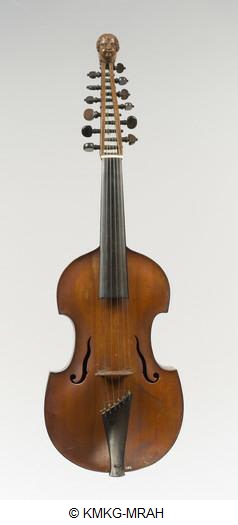
↑ , :
:
collectionName : String instrumentsinventoryNb : 0482
objectName :
objectTitle :
objectCulture :
geography :
dating : AD 1700 - AD 1734
material :
technique :
dimensions : Height: 76,3 cm, Width: 23,3 cm
legalRightOwner : Musées royaux d'art et d'histoire/Koninklijke Musea voor Kunst en Geschiedenis
objectDescription : Viola d’amore by Georg Ama (n) (1671-after 1717) from Vils, with 6 stopped strings and 6 sympathetic strings. The instrument, with a transparent red-brown varnish for the sound box, and an opaque brown varnish for the pegbox and head, is in fairly good condition. The flat back made of two pieces of bird's eye maple is widened by means of two extra pieces on the shoulders. It has an angle in the upper part and a wide open fracture in one of the upper shoulders. The ribs are also made of bird-eye maple. The lower band appears to be made in one piece. The top made of two parts of fine grained spruce has a black edge, and more inwards one black line has been painted to imitate a three-part purfling. The flame-shaped sound holes do not seem undercut. Fingerboard and tailpiece, with ebony veneer, are probably original. The sloping tailpiece, with six hooks for attaching the sympathetic strings at the bottom and the normal strings at the top, is attached to a white twisted knob with a loop. A soundpost plate is provided inside. A winged head with curly hair adorns the simple pegbox. The latter is open both above and below. The tuning keys are of different make, the pegs for the resonance strings are smaller than the six others. The printed label states: "Georg Aman, Lauten- and Geigenmacher in Augspurg". Aman is especially appreciated for his cellos and double basses. This viola d 'amore (inv. No. 0481) was part of the Auguste Tolbecque collection. In 1879 his collection of musical instruments was purchased by the Instrument Museum. L approx. 77.7 cm L. approx.23.5 cm. H. sides: approx. 5.1 cm String length: approx. 36.7 cm Bibliography Victor-Charles Mahillon, Catalogue descriptif et analytique du Musée Instrumental du Conservatoire Royal de Musique de Bruxelles, pt. 1, Ghent, 2/1893, pp. 466-467.
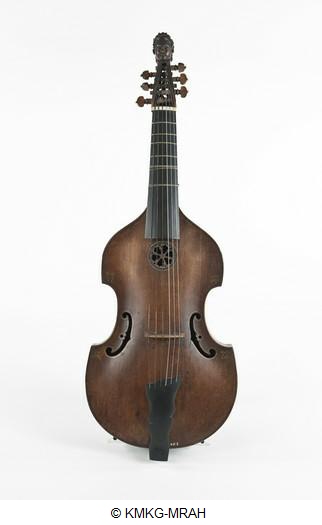
↑ , :
:
collectionName : String instrumentsinventoryNb : 0483
objectName :
objectTitle :
objectCulture :
geography :
dating : AD 1701 - AD 1800
material :
technique :
dimensions : Height: 70,8 cm, Width: 25,7 cm, Depth: 10,5 cm
legalRightOwner : Musées royaux d'art et d'histoire/Koninklijke Musea voor Kunst en Geschiedenis
objectDescription : Six-string treble viol with a label bearing the name of Nicolas III Médard (1628-after 1673) from Nancy. Most probably this instrument was put together in the nineteenth century using old and new elements, perhaps by violin maker and collector Tolbecque himself. The multi-part back is completely flat with French lilies ("fleurs de lys") in gold paint in the corners and with various strips of inlay lengthwise. There is no purfling and no angle in the upper part. The back is reinforced inside by a wide soundpost plate. The ribs are also made of rosewood layers interspersed with cypress and thin strips of veneer. The top made of two-part spruce contains a fringed rosette and is also decorated with painted French lilies in the corners. It shows a number of repaired fractures. The fringed C-holes have a notch on the inside and a circle on the outside. The thin flat neck in pearwood contains a fingerboard with ebony veneer and an ivory top nut. The simply decorated pegbox is open at the back. It has a curly plant motif and is crowned with a sculpted female head with curly hair. The tuning pegs are made of boxwood, while the tailpiece and the tailpiece bar are in ebony. The top and neck are varnished dark brown and the back and ribs are covered with a transparent, almost colorless varnish. The angular way in which the shoulders overflow into the neck base, and the unusual features of the sound box suggest that an old neck was combined with a more recent sound box. This treble viol (inv.no. 0483) has a printed label, most probably false, on which the last two digits of the year are added by hand: “Nicolas Medar à Paris 1701”. Treble viols were tuned an octave higher than the six-string bass gamba and were often used to perform similar music. L. approx. 71 cm. L. approx. 25.1 cm. H sides approx. 4.4 cm. String length approx. 38 cm. This instrument (inv. No. 0483) was part of the Auguste Tolbecque collection. In 1879 his collection of musical instruments was purchased by the Instrument Museum. In 1885 a "viol" by Nicholas Medaer from the Museum, dated 1700, was exhibited in London. Probably this instrument was meant. Bibliography Victor-Charles Mahillon, Catalogue descriptif et analytique du Musée Instrumental du Conservatoire Royal de Musique de Bruxelles, pt. 1, Ghent, 1893, p. 467.
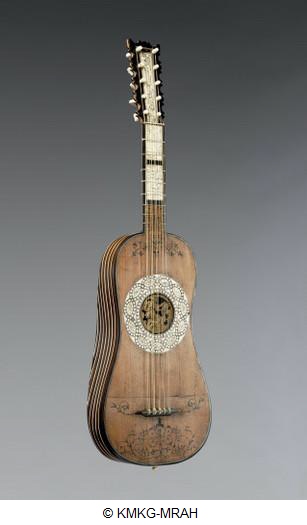
↑ , Five-course guitar:
Five-course guitar :
collectionName : String instrumentsinventoryNb : 0550
objectName :
objectTitle : Five-course guitar
objectCulture :
geography :
dating : ca. AD 1640
material :
technique :
dimensions : Height: 87,5 cm, Width: 26 cm, Depth: 13 cm
legalRightOwner : Musées royaux d'art et d'histoire/Koninklijke Musea voor Kunst en Geschiedenis
objectDescription : Guitar inv. no. 0550 was bought by the first curator of the Brussels Musical Instruments Museum, Victor-Charles Mahillon, in 1879. It was formerly property of the well-known luthier Auguste Tolbecque. The pegbox bears an engraved inscription: ‘Matheo Sellas / alla Corona in / Venetia’. Sellas was an instrument maker of German origin, active in Venice in the first half of the 17th century. The guitar has five choirs and ten dorsal pegs. The back of the soundbox is made of 23 rosewood ribs separated with ivory. The rose on the soundboard is made of lead, but probably not original. It shows a harpsichord player and is signed ‘H H’. It probably comes from a keyboard instrument by Henri Hemsch. The rose is decorated with a large inlay of ivory, black paste and rosewood. On the fingerboard, ivory plates illustrate two fables by Phaedrus or Aesop: “The Wolf and the Crane” and “The Fox and the Stork”. The back of the neck is made of an inlay of ivory and black paste. At some time, this guitar has been transformed into chitarra battente, the strings being attached at the bottom of the soundbox. At the same time, the neck was shortened and has remained the same until now. The guitar was transformed once again into a more classical instrument with a glued bridge. Possibly this work was done by Tolbecque. Radiographies give evidence of important internal transformations of the original instrument, but its external aspect remains significant of the remarkable make of baroque guitars. Bibliography Victor-Charles Mahillon, Catalogue descriptif et analytique du Musée Instrumental du Conservatoire Royal de Musique de Bruxelles, i, Gent, 1893, p. 481. Exposiçao Internacional de Instrumentos Antigos, V Festival Gulbenkian de Musica, Lisbonne, 1961, n° 39. Instruments de musique des XVIe et XVIIe siècles, catalogue de l’exposition du Musée Instrumental de Bruxelles en l’Hôtel de Sully, Paris, juin 1969, s.l., 1969, n° 31. Mia Awouters, "Befaamde barokgitaren uit de verzameling van het Brussels Instrumentenmuseum", Musica Antiqua, 3/3, 1986, p. 74-75. http://www.mim.be/baroque-guitar

↑ , :
:
collectionName : Wind instrumentsinventoryNb : 0610
objectName :
objectTitle :
objectCulture :
geography :
dating : AD 1551 - AD 1600
material :
technique :
dimensions : Height: 40,5 cm, Width: 2 cm, Depth: 17 cm
legalRightOwner : Musées royaux d'art et d'histoire/Koninklijke Musea voor Kunst en Geschiedenis
objectDescription : item has no descption

↑ , :
:
collectionName : Wind instrumentsinventoryNb : 0611
objectName :
objectTitle :
objectCulture :
geography :
dating : AD 1551 - AD 1600
material :
technique :
dimensions : Height: 59 cm, Width: 3 cm, Depth: 19,5 cm
legalRightOwner : Musées royaux d'art et d'histoire/Koninklijke Musea voor Kunst en Geschiedenis
objectDescription : item has no descption

↑ , :
:
collectionName : Wind instrumentsinventoryNb : 0614
objectName :
objectTitle :
objectCulture :
geography :
dating : AD 1551 - AD 1600
material :
technique :
dimensions : Height: 81 cm, Width: 3,5 cm, Depth: 28 cm
legalRightOwner : Musées royaux d'art et d'histoire/Koninklijke Musea voor Kunst en Geschiedenis
objectDescription : item has no descption

↑ , :
:
collectionName : Wind instrumentsinventoryNb : 0615
objectName :
objectTitle :
objectCulture :
geography :
dating : AD 1551 - AD 1600
material :
technique :
dimensions : Height: 95 cm, Width: 3,5 cm, Depth: 29 cm
legalRightOwner : Musées royaux d'art et d'histoire/Koninklijke Musea voor Kunst en Geschiedenis
objectDescription : item has no descption

↑ , :
:
collectionName : String instrumentsinventoryNb : 1388
objectName :
objectTitle :
objectCulture :
geography :
dating : AD 1730
material :
technique :
dimensions : Height: 72,5 cm, Width: 24,3 cm
legalRightOwner : Musées royaux d'art et d'histoire/Koninklijke Musea voor Kunst en Geschiedenis
objectDescription : Viola d’amore made in 1730 in today's Polish Wroczlaw (Breslau) by violin maker Andreas Ostler (1692-after 1770), with 6 stopped strings and 6 sympathetic strings. The instrument, with a golden yellow varnish, is in fairly good condition. The flat back made of two symmetrical pieces of flamed maple is gently angled to the neck and has a pear trim in the middle to compensate for the open seam. The ribs are made of maple with flames of different widths. The top made of two-part fine grained spruce has an ebony edge and in addition a three-part purfling. The arching has dropped slightly in the middle near the flame-shaped sound holes that have not been undercut. There are some restored fractures visible in both top and back. Pins are inserted at the bottom of the ribs for fixing the six metal sympathetic strings. Fingerboard and tailpiece, with ebony veneer, are probably original. The tailpiece, with six pins for attaching the normal strings, is attached with a loop to a turned knob at the bottom of the ribs. Inside, linings and a soundpost plate are provided, as well as paper strips for reinforcing the top and the back. A traditional scroll with a red candle wax seal on the rib closes the elongated pegbox. The label states: "Andreas Ostler, Lauten und Geigenmacher in Breslau, A. 1730" According to a letter from 1879, the instrument was donated by music director Albert Hahn from Königsberg in Prussia, who is also editor of the magazine “Tonkunst”. L approx. 73 cm L.ca. 24.5 cm H ribs: approx. 5.5 cm String length approx. 35 cm Bibliography Victor-Charles Mahillon, Catalogue descriptif et analytique du Musée Instrumental du Conservatoire Royal de Musique de Bruxelles, pt. 3, Ghent, 1900, p. 37.

↑ , Rectangular muselar virginal:
Rectangular muselar virginal :
collectionName : Keyboard instrumentsinventoryNb : 1597
objectName :
objectTitle : Rectangular muselar virginal
objectCulture :
geography :
dating : AD 1620
material :
technique :
dimensions : Height: 26 cm, Width: 173,8 cm, Depth: 49,5 cm
legalRightOwner : Musées royaux d'art et d'histoire/Koninklijke Musea voor Kunst en Geschiedenis
objectDescription : Muselar virginal on 6 legs, bearing the serial number 6/27, built by Andreas Ruckers in 1620. Its refurbishment was probably completed by the end of the seventeenth century. Restored in 1847 by Bruno Martens, in 1885 by Frans de Vestibule, in 1936–1937 by Siméon Moisse and in 1982 by Kurt and Susanne Wittmayer.

↑ , Yang-kin, Yang-ch'in, Yangqin:
Yang-kin, Yang-ch'in, Yangqin :
collectionName : Asian musical instrumentsinventoryNb : 1932
objectName :
objectTitle : Yang-kin, Yang-ch'in, Yangqin
objectCulture :
geography :
dating : before AD 1900
material :
technique :
dimensions :
legalRightOwner : Musées royaux d'art et d'histoire/Koninklijke Musea voor Kunst en Geschiedenis
objectDescription : item has no descption

↑ , :
:
collectionName : Percussion instrumentsinventoryNb : 1970.022
objectName :
objectTitle :
objectCulture :
geography :
dating : AD 1595
material :
technique :
dimensions :
legalRightOwner : Musées royaux d'art et d'histoire/Koninklijke Musea voor Kunst en Geschiedenis
objectDescription : item has no descption

↑ , Fretted clavichord:
Fretted clavichord :
collectionName : Keyboard instrumentsinventoryNb : 1970.029
objectName :
objectTitle : Fretted clavichord
objectCulture :
geography :
dating : AD 1733
material :
technique :
dimensions : Height: 13,4 cm, Width: 120,7 cm, Depth: 36,8 cm
legalRightOwner : Musées royaux d'art et d'histoire/Koninklijke Musea voor Kunst en Geschiedenis
objectDescription : item has no descption

↑ , :
:
collectionName : Keyboard instrumentsinventoryNb : 1971.027
objectName :
objectTitle :
objectCulture :
geography :
dating : AD 1633
material :
technique :
dimensions :
legalRightOwner : Musées royaux d'art et d'histoire/Koninklijke Musea voor Kunst en Geschiedenis
objectDescription : 6-voet muselar virginal bearing the serial number 6/70, built by Andreas Ruckers in 1633. Enlarged in both the bass and treble in the eighteenth or even nineteenth century. Restored probably in Claude Mercier-Ythier’s workshop in 1964 and in 2013 thanks to the patronage of the Fonds Baillet Latour.

↑ , :
:
collectionName : Wind instrumentsinventoryNb : 1980.057
objectName :
objectTitle :
objectCulture :
geography :
dating : ca. AD 1900
material :
technique :
dimensions : Height: 83 cm, Width: 23,5 cm, Depth: 37,5 cm
legalRightOwner : Musées royaux d'art et d'histoire/Koninklijke Musea voor Kunst en Geschiedenis
objectDescription : item has no descption

↑ , :
:
collectionName : Sculpture and Furniture (XIII - XIX centuries)inventoryNb : 2335
objectName :
objectTitle :
objectCulture :
geography :
dating : AD 1480 - AD 1490 unknown
material :
technique :
dimensions :
legalRightOwner : Musées royaux d'art et d'histoire/Koninklijke Musea voor Kunst en Geschiedenis
objectDescription : item has no descption

↑ , Rectangular muselar virginal:
Rectangular muselar virginal :
collectionName : Keyboard instrumentsinventoryNb : 2930
objectName :
objectTitle : Rectangular muselar virginal
objectCulture :
geography :
dating : AD 1614 (uncertain)
material :
technique :
dimensions : Length: 1667 mm, Width: 490 mm, Height: 240 mm
legalRightOwner : Musées royaux d'art et d'histoire/Koninklijke Musea voor Kunst en Geschiedenis
objectDescription : Muselar virginal on 6 legs, bearing the serial number 6/20, probably built in 1614. Restyled several times according to current tastes. In the first half of the 18th century, the original porphyry decoration was covered with a brownish colour. During the 19th century, that brown was then hidden under faux-wood and the instrument was given a new lid. Also during the 19th century, the instrument was redecorated with geometrical motifs. A new fallboard and jackrail were added. A flap was cut out of the lid above the keys while the soundboard and bridges were painted in a milky brown. The soundboard was enhanced with decorative motifs. Some of these alterations could have been the work of a certain I.B.P., who left his signature on the nameboard liner. Restored in the 1960s.

↑ , Rectangular muselar virginal:
Rectangular muselar virginal :
collectionName : Keyboard instrumentsinventoryNb : 2933
objectName :
objectTitle : Rectangular muselar virginal
objectCulture :
geography :
dating : AD 1638
material :
technique :
dimensions :
legalRightOwner : Musées royaux d'art et d'histoire/Koninklijke Musea voor Kunst en Geschiedenis
objectDescription : Muselar virginal on 6 legs, bearing the serial number 6/68 and built by Ioannes Ruckers in 1638 according to the date inscribed on the soundboard. Underwent a refurbishment, probably in the eighteenth century. Restored at least once, probably several times.

↑ , Harpsichord with double keyboard:
Harpsichord with double keyboard :
collectionName : Keyboard instrumentsinventoryNb : 2934
objectName :
objectTitle : Harpsichord with double keyboard
objectCulture :
geography :
dating : ca. AD 1585
material :
technique :
dimensions : Height: 27,1 cm, Width: 79,4 cm, Depth: 224,2 cm
legalRightOwner : Musées royaux d'art et d'histoire/Koninklijke Musea voor Kunst en Geschiedenis
objectDescription : Double-manual harpsichord long considered a Hans Ruckers instrument, built by a Flemish maker around 1585. The oldest extant double-manual Flemish harpsichord. It originally had two manuals, one of which was transposing, two ranks of strings (1x4’, 1x8’), but only three registers. Alignment of the keyboards and grand refurbishment, probably as early as in the seventeenth century. Further touchup at some time in the eighteenth century. Restored in 2015 thanks to the patronage of the Foundation Baillet Latour.

↑ , :
:
collectionName : Sculpture and Furniture (XIII - XIX centuries)inventoryNb : 3146
objectName :
objectTitle :
objectCulture :
geography :
dating : AD 1501 - AD 1600
material :
technique :
dimensions : Height: 33 cm
legalRightOwner : Musées royaux d'art et d'histoire/Koninklijke Musea voor Kunst en Geschiedenis
objectDescription : item has no descption

↑ , Harpsichord with double keyboard:
Harpsichord with double keyboard :
collectionName : Keyboard instrumentsinventoryNb : 3848
objectName :
objectTitle : Harpsichord with double keyboard
objectCulture :
geography :
dating : ca. AD 1695
material :
technique :
dimensions : Length: 2263 cm, Width: 898 cm, Height: 919 cm
legalRightOwner : Musées royaux d'art et d'histoire/Koninklijke Musea voor Kunst en Geschiedenis
objectDescription : Double-manual harpsichord long considered an instrument by Hans Ruckers, built by a French maker around 1695. Lid and fallboard paintings attributed to the studio of Martin des Batailles and to Pierre-Denis Martin. First refurbishment probably by Antoine Vater around 1750. Second refurbishment by Pascal Taskin in 1774. Restored in 1905 in Paris by the Italian piano maker and restorer Louis Tomasini, in the 1950s by the American harpsichord maker Frank Hubbard and in 1996 thanks to funds from the King Baudouin Foundation.
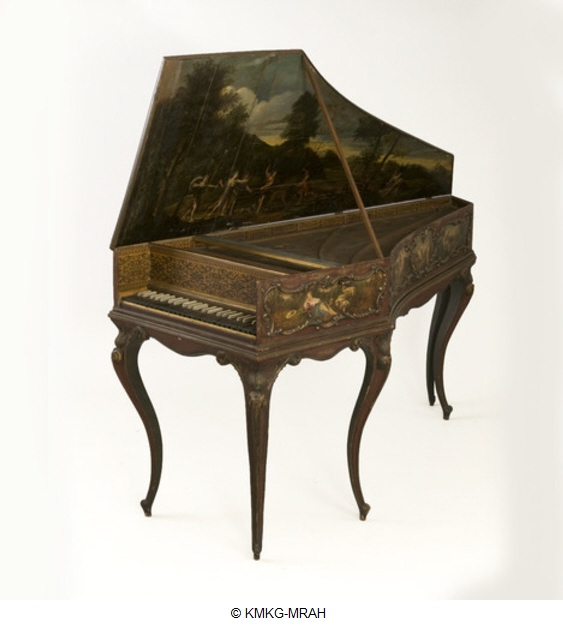
↑ , Harpsichord:
Harpsichord :
collectionName : Keyboard instrumentsinventoryNb : 3908
objectName :
objectTitle : Harpsichord
objectCulture :
geography :
dating : ca. AD 1600 - AD 1620
material :
technique :
dimensions :
legalRightOwner : Musées royaux d'art et d'histoire/Koninklijke Musea voor Kunst en Geschiedenis
objectDescription : Flemish harpsichord from the early seventeenth century, formerly considered an Andreas Ruckers instrument. Probably as early as the 17th century, the instrument has undergone a first refurbishment. The soundboard was redecorated, most likely sometime in the eighteenth century. In the late nineteenth or even twentieth century, a new keyboard was placed into the instrument; a second rank of 8’ strings was added while the 4’ was abandoned. The case then received a Louis XV-style decoration.

↑ , :
:
collectionName : Wind instrumentsinventoryNb : 4246
objectName :
objectTitle :
objectCulture :
geography :
dating : AD 1851 - AD 1900
material :
technique :
dimensions : Height: 47 cm
legalRightOwner : Musées royaux d'art et d'histoire/Koninklijke Musea voor Kunst en Geschiedenis
objectDescription : item has no descption
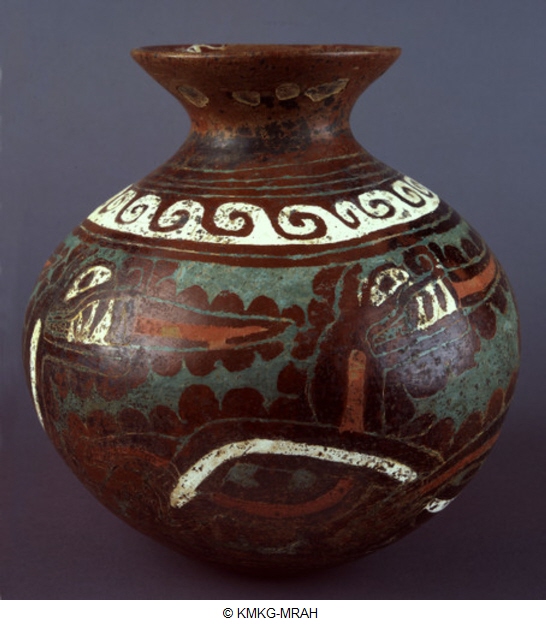
↑ , :
:
collectionName : AmericainventoryNb : AAM 00070.6
objectName :
objectTitle :
objectCulture : Tarascans (Purépecha)
geography :
dating : AD 1 - AD 500
material :
technique :
dimensions : Height: 23,5 cm
legalRightOwner : Musées royaux d'art et d'histoire/Koninklijke Musea voor Kunst en Geschiedenis
objectDescription : item has no descption
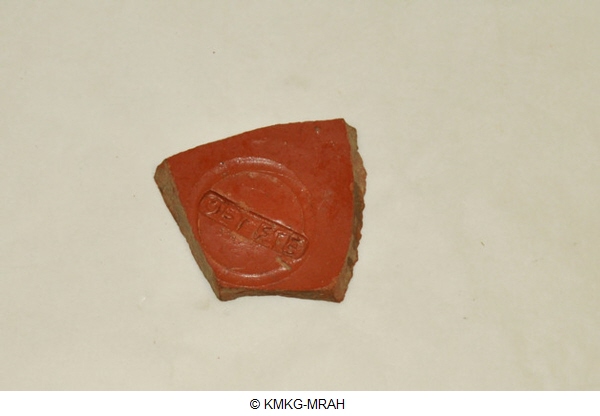
↑ , :
:
collectionName : Gallo-RomaninventoryNb : B000474-010
objectName :
objectTitle :
objectCulture : Gallo-Roman
geography :
dating :
material :
technique :
dimensions :
legalRightOwner : Musées royaux d'art et d'histoire/Koninklijke Musea voor Kunst en Geschiedenis
objectDescription : Base of a plate in terra sigillata, Drag. 28, with seal OFTSFE (probably Flavus and Secundus).

↑ , :
:
collectionName : Prehistory and Metal AgesinventoryNb : B001376-001
objectName :
objectTitle :
objectCulture : Michelsberg
geography :
dating :
material :
technique :
dimensions : Length: 3,5 cm
legalRightOwner : Musées royaux d'art et d'histoire/Koninklijke Musea voor Kunst en Geschiedenis
objectDescription : Gift from M. Et. Verhaegen to the RMAH in 1908. The material dates back to the Middle Neolithic period (probably Michelsberg or S.O.M.) and comes from Boitsfort (without more precise location).
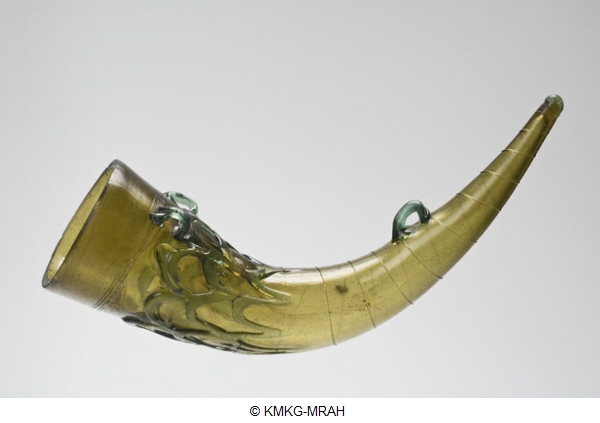
↑ , :
:
collectionName : MerovingiansinventoryNb : B005829-001
objectName :
objectTitle :
objectCulture : Merovingian
geography :
dating :
material :
technique :
dimensions : Height: 20,3 cm
legalRightOwner : Musées royaux d'art et d'histoire/Koninklijke Musea voor Kunst en Geschiedenis
objectDescription : In the early Middle Ages, people were buried with various grave goods. This drinking horn, acquired by the museum in 2010, is probably from the cemetery of Anderlecht, where it was unearthed during early excavations. Its previous owner discovered it as a child in the attic of his grandfather, a Brussels notary. A greenish yellow, heightened with a net pattern and three rings, all bluish green, it is distinctive for its large size. Related to similar net-decorated horns form Lombardy, it could nonetheless be a local product. Intact ancient or medieval glass drinking horns are quite rare.
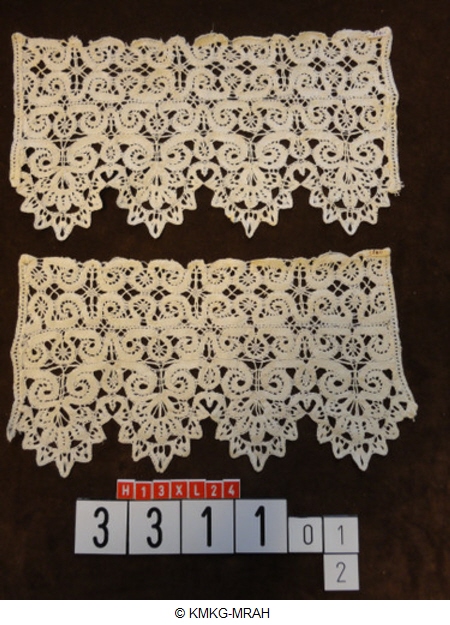
↑ , Probably two pairs of cuffs:
Probably two pairs of cuffs :
collectionName : LaceinventoryNb : D.3311.00
objectName :
objectTitle : Probably two pairs of cuffs
objectCulture :
geography :
dating : ca. AD 1625
material :
technique :
dimensions :
legalRightOwner : Musées royaux d'art et d'histoire/Koninklijke Musea voor Kunst en Geschiedenis
objectDescription : item has no descption

↑ , Probably cuff:
Probably cuff :
collectionName : LaceinventoryNb : D.3311.01
objectName :
objectTitle : Probably cuff
objectCulture :
geography :
dating : ca. AD 1625
material :
technique :
dimensions : Height: 13 cm, Width: 24 cm
legalRightOwner : Musées royaux d'art et d'histoire/Koninklijke Musea voor Kunst en Geschiedenis
objectDescription : item has no descption

↑ , Probably cuff:
Probably cuff :
collectionName : LaceinventoryNb : D.3311.02
objectName :
objectTitle : Probably cuff
objectCulture :
geography :
dating : ca. AD 1625
material :
technique :
dimensions : Height: 13 cm, Width: 24 cm
legalRightOwner : Musées royaux d'art et d'histoire/Koninklijke Musea voor Kunst en Geschiedenis
objectDescription : item has no descption
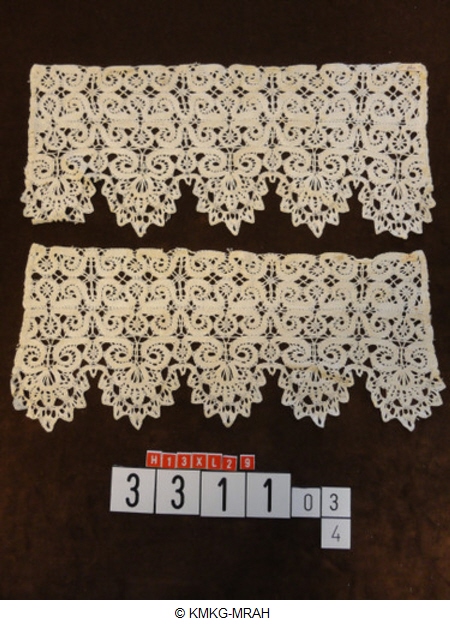
↑ , Probably cuff:
Probably cuff :
collectionName : LaceinventoryNb : D.3311.03
objectName :
objectTitle : Probably cuff
objectCulture :
geography :
dating : ca. AD 1625
material :
technique :
dimensions : Height: 13 cm, Width: 29 cm
legalRightOwner : Musées royaux d'art et d'histoire/Koninklijke Musea voor Kunst en Geschiedenis
objectDescription : item has no descption

↑ , Probably cuff:
Probably cuff :
collectionName : LaceinventoryNb : D.3311.04
objectName :
objectTitle : Probably cuff
objectCulture :
geography :
dating : ca. AD 1625
material :
technique :
dimensions : Height: 13 cm, Width: 29 cm
legalRightOwner : Musées royaux d'art et d'histoire/Koninklijke Musea voor Kunst en Geschiedenis
objectDescription : item has no descption

↑ , Oval plaque with monkey and "nfr":
Oval plaque with monkey and "nfr" :
collectionName : EgyptinventoryNb : E.02110
objectName :
objectTitle : Oval plaque with monkey and "nfr"
objectCulture : Egyptian
geography :
dating : 1295 BC - 1186 BC (uncertain)
material :
technique :
dimensions : Height: 1,2 cm, Width: 0,8 cm, Depth: 0,4 cm
legalRightOwner : Musées royaux d'art et d'histoire/Koninklijke Musea voor Kunst en Geschiedenis
objectDescription : The inscription reads “nfr.w”, ‘good things’. 18-19th dynasty, probably 19th.

↑ , Cowroid displaying Bes:
Cowroid displaying Bes :
collectionName : EgyptinventoryNb : E.02795
objectName :
objectTitle : Cowroid displaying Bes
objectCulture : Egyptian
geography :
dating : 1295 BC - 1069 BC
material :
technique :
dimensions : Height: 4,3 cm, Width: 2,2 cm, Depth: 1 cm
legalRightOwner : Musées royaux d'art et d'histoire/Koninklijke Musea voor Kunst en Geschiedenis
objectDescription : This kauroid seal has a flat top and a band with cross-hatching running around the sides. The base shows three registers, separated by a double line. Above and below are two uraei on each side of a beetle. In the middle, a prisoner to the right, his arms tied on his back, and to his left the god Bes drinking from a vase with a straw (also E.5353). Bes became popular on seals starting from the Ramessid period onwards. The division into registers appears on Ramessid scarabs as well and therefore this seal probably dates from the 19th-20th century.
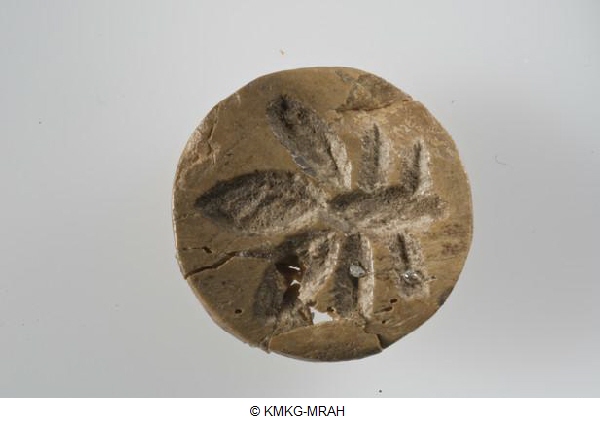
↑ , Button seal decorated with dragonfly:
Button seal decorated with dragonfly :
collectionName : EgyptinventoryNb : E.03028
objectName :
objectTitle : Button seal decorated with dragonfly
objectCulture : Egyptian
geography :
dating : 2345 BC - 2181 BC
material :
technique :
dimensions : Height: 0,7 cm
legalRightOwner : Musées royaux d'art et d'histoire/Koninklijke Musea voor Kunst en Geschiedenis
objectDescription : The base of this seal amulet shows an insect, probably a dragon fly; Similar seals date from the 6th dynasty.

↑ , Scarab with Thoth and Re-Horakhty:
Scarab with Thoth and Re-Horakhty :
collectionName : EgyptinventoryNb : E.04579b
objectName :
objectTitle : Scarab with Thoth and Re-Horakhty
objectCulture : Egyptian
geography :
dating : 1550 BC - 1069 BC
material :
technique :
dimensions : Height: 1,5 cm, Width: 1,1 cm, Depth: 0,7 cm
legalRightOwner : Musées royaux d'art et d'histoire/Koninklijke Musea voor Kunst en Geschiedenis
objectDescription : The base of this scarab shows a seated baboon, the animal of the god Thoth, to the left, in his function as moon god (identifiable by the solar disk with moon crescent above his head), and to the right a seated falcon-headed god with a solar disk above his head, Re-Horachte (Horus in his function as solar deity). Probably a Ramessid scarab (19th-20th dynasty).

↑ , Scarab (fake):
Scarab (fake) :
collectionName : EgyptinventoryNb : E.04862
objectName :
objectTitle : Scarab (fake)
objectCulture : Egyptian
geography :
dating : (uncertain)
material :
technique :
dimensions : Height: 8 cm, Width: 5,6 cm, Depth: 2,8 cm
legalRightOwner : Musées royaux d'art et d'histoire/Koninklijke Musea voor Kunst en Geschiedenis
objectDescription : This large scarab in blue-green glazed steatite shows, on the base, a scene with two fighting bulls. Above them are two large birds with a crest, on each side of a large solar disk. Below the figures, a “nb” basket, partly preserved. This is a modern scarab, probably produced in the 19th century.
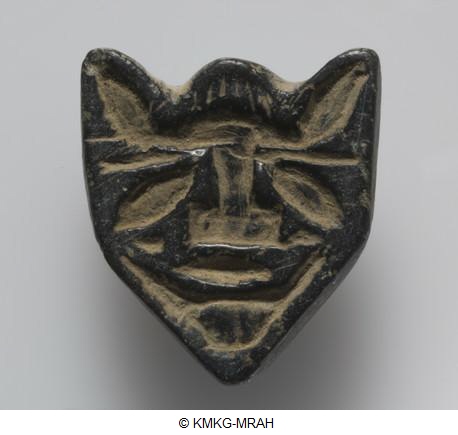
↑ , Seal-amulet in the shape of a human face (?):
Seal-amulet in the shape of a human face (?) :
collectionName : EgyptinventoryNb : E.04936
objectName :
objectTitle : Seal-amulet in the shape of a human face (?)
objectCulture : Egyptian
geography :
dating : 2160 BC - 2025 BC
material :
technique :
dimensions : Height: 2,8 cm, Width: 2,5 cm, Depth: 1,3 cm
legalRightOwner : Musées royaux d'art et d'histoire/Koninklijke Musea voor Kunst en Geschiedenis
objectDescription : Similar seal amulets are known from the First Intermediate Period and probably represent a human face on the base.

↑ , Wdjat-eye seal-amulet:
Wdjat-eye seal-amulet :
collectionName : EgyptinventoryNb : E.04937
objectName :
objectTitle : Wdjat-eye seal-amulet
objectCulture : Egyptian
geography :
dating : 1550 BC - 1069 BC
material :
technique :
dimensions : Height: 1,9 cm, Width: 1 cm, Depth: 0,4 cm
legalRightOwner : Musées royaux d'art et d'histoire/Koninklijke Musea voor Kunst en Geschiedenis
objectDescription : The base of this scaraboid in the shape of a wdjat eye shows a worshipping scene: before an enthroned goddess sits a second goddess, with a cobra above her head and the life sign “ankh” in her left hand. Both stretch out one hand towards a long papyrus sceptre. The goddess on the right side, with an animal head, is probably the lion-goddess Sechmet, who is often depicted with this type of sceptre. The enthroned goddess has two horns on her head and is possibly Isis or Hathor.
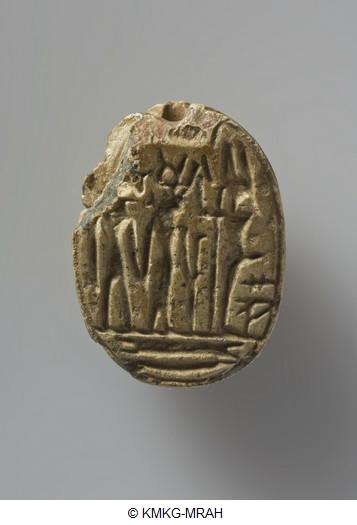
↑ , Scarab of Ramesses II:
Scarab of Ramesses II :
collectionName : EgyptinventoryNb : E.05028
objectName :
objectTitle : Scarab of Ramesses II
objectCulture : Egyptian
geography :
dating : 1279 BC - 1213 BC
material :
technique :
dimensions : Height: 2,2 cm, Width: 1,6 cm, Depth: 0,8 cm
legalRightOwner : Musées royaux d'art et d'histoire/Koninklijke Musea voor Kunst en Geschiedenis
objectDescription : The name of Ramses II is written in two cartouches on the back of this scarab: “wsr-maAt-ra stp-n-ra mry-imn ra-ms-s”. On the base we see three gods on the hieroglyph “mr”, ‘beloved’: the fertility god Min, the goddess Hathor with on her head a solar disk between two cow horns, holding a falcon-headed deity, probably her son Horus, by the hand. Below, to the right, an inscription that reads “mr(y).s”, ‘beloved by him’. Above the scene, the solar disk of Ra and below the hieroglyph “nb”, ‘lord’.

↑ , Cylinder seal with some hieroglyphs:
Cylinder seal with some hieroglyphs :
collectionName : EgyptinventoryNb : E.05034
objectName :
objectTitle : Cylinder seal with some hieroglyphs
objectCulture : Egyptian
geography :
dating : 3000 BC - 2686 BC
material :
technique :
dimensions : Height: 1,8 cm, Width: 1,7 cm
legalRightOwner : Musées royaux d'art et d'histoire/Koninklijke Musea voor Kunst en Geschiedenis
objectDescription : This cylinder seal in black steatite wears some hieroglyphic symbols with an uncertain meaning. The piece, which probably came from a grave, was used by its owner to “draw” on clay. It dates from the Thinite period.
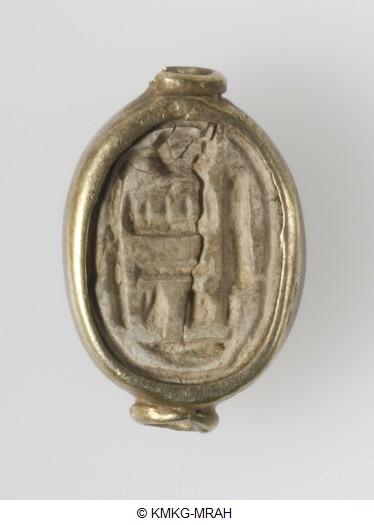
↑ , Scarab with the name of Amon-re in its mounting:
Scarab with the name of Amon-re in its mounting :
collectionName : EgyptinventoryNb : E.05362
objectName :
objectTitle : Scarab with the name of Amon-re in its mounting
objectCulture : Egyptian
geography :
dating : 1550 BC - 1295 BC
material :
technique :
dimensions : Height: 1,4 cm, Width: 0,9 cm, Depth: 0,5 cm
legalRightOwner : Musées royaux d'art et d'histoire/Koninklijke Musea voor Kunst en Geschiedenis
objectDescription : The base of this scarab shows hieroglyphs which form the name of the god Amon Ra next to a lotus stalk. Scarabs with similar inscriptions date from the 18th dynasty. The original gold mounting is preserved; the scarab was probably originally attached to a ring.

↑ , Scarab:
Scarab :
collectionName : EgyptinventoryNb : E.05379
objectName :
objectTitle : Scarab
objectCulture : Egyptian
geography :
dating : 1295 BC - 1069 BC
material :
technique :
dimensions : Height: 1,3 cm, Width: 0,9 cm, Depth: 0,6 cm
legalRightOwner : Musées royaux d'art et d'histoire/Koninklijke Musea voor Kunst en Geschiedenis
objectDescription : The base of this scarab shows three motifs. From right to left: the obelisk, the seated goddess Maat and the solar disk “ra”. This could be a cryptogram of the name Amon Ra, “imn ra”. The scarab probably dates from the Ramessid Period or somewhat later.

↑ , Scarab with bird:
Scarab with bird :
collectionName : EgyptinventoryNb : E.05381
objectName :
objectTitle : Scarab with bird
objectCulture : Egyptian
geography :
dating : 1550 BC - 1295 BC
material :
technique :
dimensions : Height: 1,4 cm, Width: 1 cm, Depth: 0,6 cm
legalRightOwner : Musées royaux d'art et d'histoire/Koninklijke Musea voor Kunst en Geschiedenis
objectDescription : The base of this scarab shows a bird (duck), lifting off. Behind it, a small oval, probably an egg.
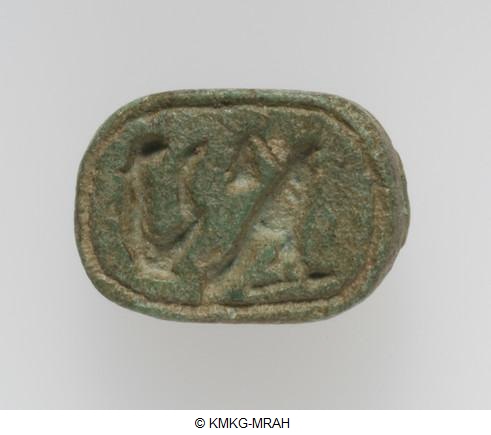
↑ , Scarab:
Scarab :
collectionName : EgyptinventoryNb : E.05590b
objectName :
objectTitle : Scarab
objectCulture : Egyptian
geography :
dating : 747 BC - 525 BC
material :
technique :
dimensions : Height: 1 cm, Width: 0,7 cm, Depth: 0,5 cm
legalRightOwner : Musées royaux d'art et d'histoire/Koninklijke Musea voor Kunst en Geschiedenis
objectDescription : The base of this scarab shows a falcon with flagellum in front of a seated figure with ostrich feather on his knees, probably the goddess Maat.
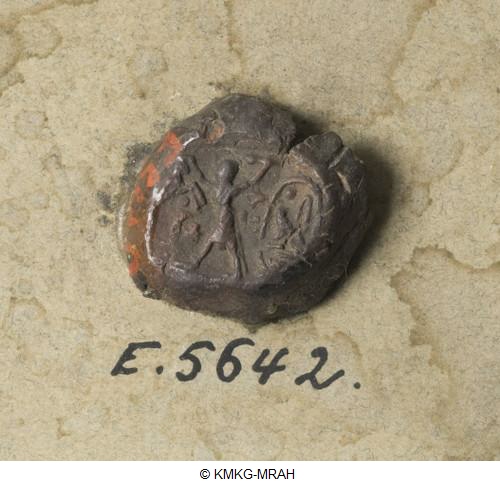
↑ , Seal imprint:
Seal imprint :
collectionName : EgyptinventoryNb : E.05642
objectName :
objectTitle : Seal imprint
objectCulture : Egyptian
geography :
dating : 1550 BC - 1069 BC (uncertain)
material :
technique :
dimensions : Height: 1,7 cm, Width: 1,5 cm, Depth: 0,5 cm
legalRightOwner : Musées royaux d'art et d'histoire/Koninklijke Musea voor Kunst en Geschiedenis
objectDescription : This small seal imprint in terracotta probably shows a king with a club beating a quadruped which he raises with his hand. According to the cartouche accompanying the depiction, this is probably Psammetichus I.

↑ , Scarab of Thutmosis III:
Scarab of Thutmosis III :
collectionName : EgyptinventoryNb : E.05704.9b
objectName :
objectTitle : Scarab of Thutmosis III
objectCulture : Egyptian
geography :
dating : 1295 BC - 1069 BC (uncertain)
material :
technique :
dimensions : Height: 1,6 cm, Width: 1,3 cm, Depth: 0,8 cm
legalRightOwner : Musées royaux d'art et d'histoire/Koninklijke Musea voor Kunst en Geschiedenis
objectDescription : Scarab with an inscription naming Thutmosis III, whose name can be seen in the central oval: “mn-khpr-re”. Above, the royal epithet “nTr nfr nb tAwy”, ‘the good god, lord of the Two Lands’. Below stands the second epithet, “tit lmn”, ‘image of Amun’. This scarab probably dates from the Ramessid Period (19th-20th dynasty). This is not exceptional for scarabs bearing the name of Thutmosis III, who was worshipped for centuries after his death and whose name appeared on scarabs until the Late Period.

↑ , Scarab of Ahmose (?):
Scarab of Ahmose (?) :
collectionName : EgyptinventoryNb : E.05790.4
objectName :
objectTitle : Scarab of Ahmose (?)
objectCulture : Egyptian
geography :
dating : 1550 BC - 1460 BC
material :
technique :
dimensions : Height: 1,4 cm, Width: 1 cm, Depth: 0,6 cm
legalRightOwner : Musées royaux d'art et d'histoire/Koninklijke Musea voor Kunst en Geschiedenis
objectDescription : The base of this scarab displays two hieroglyphs: the crescent “iaH” (?) and the sign “ms”. This inscription probably forms the name Ahmose (early 18th dynasty).
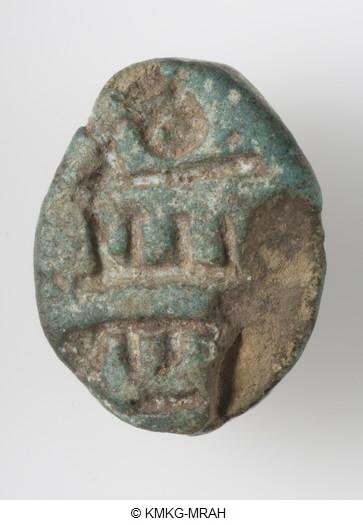
↑ , Human-head scaraboid:
Human-head scaraboid :
collectionName : EgyptinventoryNb : E.05861
objectName :
objectTitle : Human-head scaraboid
objectCulture : Egyptian
geography :
dating : 664 BC - 525 BC
material :
technique :
dimensions : Height: 2,1 cm, Width: 1,6 cm, Depth: 0,9 cm
legalRightOwner : Musées royaux d'art et d'histoire/Koninklijke Musea voor Kunst en Geschiedenis
objectDescription : The production of scaraboids with human face, in faience, seems to appear in the Ramessid Period and lasts until the Late Period. The base shows a number of hieroglyphs, from top to bottom: the sign “pA”, the arm “di” and some damaged signs, among them “mn”. They probably form the name of a person beginning with “pA-di-…”. Such names have been attested on scarabs from the 23rd-26th dynasties, when several pharaohs with this name ruled. The scaraboid was possibly produced in the workshop of Naucratis, in the Delta (late 7th-6th century).
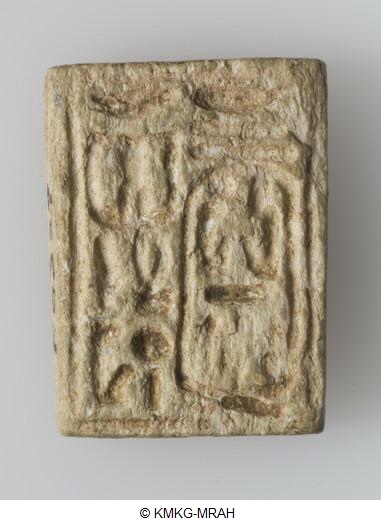
↑ , Rectangular plaque bearing the name Ramesses:
Rectangular plaque bearing the name Ramesses :
collectionName : EgyptinventoryNb : E.06327
objectName :
objectTitle : Rectangular plaque bearing the name Ramesses
objectCulture : Egyptian
geography :
dating : 1295 BC - 1069 BC
material :
technique :
dimensions : Height: 1,8 cm, Width: 1,3 cm, Depth: 0,5 cm
legalRightOwner : Musées royaux d'art et d'histoire/Koninklijke Musea voor Kunst en Geschiedenis
objectDescription : This seal amulet has on the one side (originally, the other side was probably also engraved) an inscription in hieroglyphs: “nb tAwy (mry imn ra) nb Hb mi ra”, ‘lord of the Two Lands (Ramesses), lord of the festival like Ra’. The royal name in the cartouche is only partly visible; only the motifs in the upper part can be identified as two gods, sitting in front of each other, above the sign “mr”, ‘beloved by’. Multiple kings from the 19th and especially the 20th dynasty had similar cartouches.
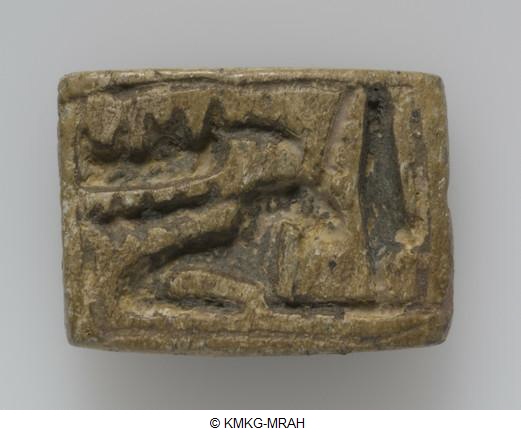
↑ , Rectangular plaque with enthroned figure bearing the name of Amun:
Rectangular plaque with enthroned figure bearing the name of Amun :
collectionName : EgyptinventoryNb : E.06328
objectName :
objectTitle : Rectangular plaque with enthroned figure bearing the name of Amun
objectCulture : Egyptian
geography :
dating : 1069 BC - 900 BC
material :
technique :
dimensions : Height: 2 cm, Width: 1,5 cm, Depth: 0,7 cm
legalRightOwner : Musées royaux d'art et d'histoire/Koninklijke Musea voor Kunst en Geschiedenis
objectDescription : This rectangular seal amulet is decorated on two sides. Side A shows a recumbent animal, probably a ram, next to the name of Amun. Side B shows a figure approaching an enthroned figure (a king) holding a sceptre in his hand. The style and similar seals point to a dating around the 21st dynasty.

↑ , Seal of Henat:
Seal of Henat :
collectionName : EgyptinventoryNb : E.06941a
objectName :
objectTitle : Seal of Henat
objectCulture : Egyptian
geography :
dating : 664 BC - 525 BC
material :
technique :
dimensions : Height: 3 cm, Width: 3,8 cm, Depth: 1,3 cm
legalRightOwner : Musées royaux d'art et d'histoire/Koninklijke Musea voor Kunst en Geschiedenis
objectDescription : This seal imprint in clay has an inscription organised in two horizontal rows. It consists of the name, title and descent of the owner: “prophet of Menkare, de high reading priest, Henat, son of Psamtek-sa-Neith”. This person and his family are known from several documents. Henat was probably a contemporary of the Persian kings. His first title (“prophet of Menkare”) shows the existence of a cult for king Menkare in the Persian Period. The imprint, which is in excellent condition (see also E.6941 B), was used for binding papyrus scrolls together.

↑ , Seal of Henat:
Seal of Henat :
collectionName : EgyptinventoryNb : E.06941b
objectName :
objectTitle : Seal of Henat
objectCulture : Egyptian
geography :
dating : 664 BC - 525 BC
material :
technique :
dimensions : Height: 3 cm, Width: 2,6 cm, Depth: 1,3 cm
legalRightOwner : Musées royaux d'art et d'histoire/Koninklijke Musea voor Kunst en Geschiedenis
objectDescription : This seal imprint in clay has an inscription organised in two horizontal rows. It consists of the name, title and descent of the owner: “prophet of Menkare, de high reading priest, Henat, son of Psamtek-sa-Neith”. This person and his family are known from several documents. Henat was probably a contemporary of the Persian kings. His first title (“prophet of Menkare”) shows the existence of a cult for king Menkare in the Persian Period. The imprint is less well preserved than the other copy (compare E.6941A) and was used to bind together papyrus scrolls.

↑ , Seal of Petenisis:
Seal of Petenisis :
collectionName : EgyptinventoryNb : E.06941c
objectName :
objectTitle : Seal of Petenisis
objectCulture : Egyptian
geography :
dating : 664 BC - 525 BC
material :
technique :
dimensions : Height: 3 cm, Width: 3,5 cm, Depth: 1,3 cm
legalRightOwner : Musées royaux d'art et d'histoire/Koninklijke Musea voor Kunst en Geschiedenis
objectDescription : This seal imprint in clay is part of a category of similar objects which carry an inscription with the royal name of Amasis, preceded by the sign “sa” (protection) and followed by the title and name of the owner. The piece of Brussels carries the name of Petenisis, also known from his grave south east of the Oenas pyramid. This man, who seems to have been connected to the royal treasury, probably lived under the government of Amasis, the second to last king of the 26th dynasty.

↑ , Scarab of Thutmosis III:
Scarab of Thutmosis III :
collectionName : EgyptinventoryNb : E.07270
objectName :
objectTitle : Scarab of Thutmosis III
objectCulture : Egyptian
geography :
dating : 1295 BC - 1069 BC
material :
technique :
dimensions : Height: 2,9 cm, Width: 2 cm, Depth: 1,1 cm
legalRightOwner : Musées royaux d'art et d'histoire/Koninklijke Musea voor Kunst en Geschiedenis
objectDescription : The base of this scarab shows a horse and a prisoner whose hands are tied behind his back. Above, an oval with the throne name of Thutmosis III, “mn-khpr-ra”. The morphology of the scarab points to a posthumous production from the Ramessid Period, probably the 19th dynasty.

↑ , :
:
collectionName : EgyptinventoryNb : E.07359
objectName :
objectTitle :
objectCulture : Egyptian
geography :
dating : 1185 BC - 1153 BC
material :
technique :
dimensions : Height: 18,1 cm, Width: 15,2 cm, Depth: 3,2 cm
legalRightOwner : Musées royaux d'art et d'histoire/Koninklijke Musea voor Kunst en Geschiedenis
objectDescription : item has no descption
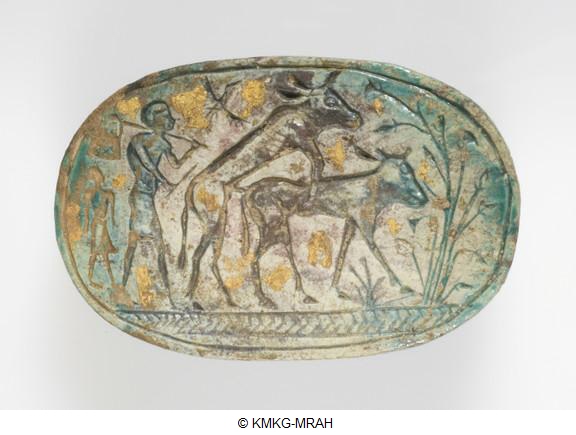
↑ , Scarab (fake):
Scarab (fake) :
collectionName : EgyptinventoryNb : E.07632
objectName :
objectTitle : Scarab (fake)
objectCulture : Egyptian
geography :
dating :
material :
technique :
dimensions : Height: 8 cm, Width: 5,2 cm, Depth: 3 cm
legalRightOwner : Musées royaux d'art et d'histoire/Koninklijke Musea voor Kunst en Geschiedenis
objectDescription : The base of this large scarab shows a scene with a mating bull and cow between papyrus plants on the banks off the Nile (the water is presented below as zigzag lines). Behind them, a bird flies up and two figures approach. The largest holds a sack on his shoulder. This is a modern scarab, probably produced during the 19th century.
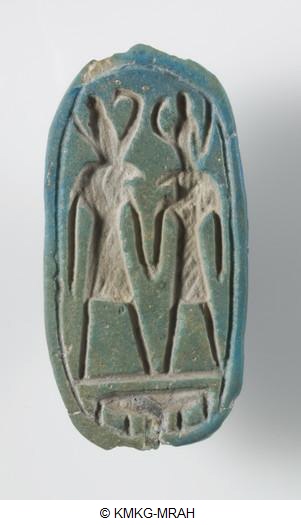
↑ , Oval plaque with bundled handle representing Horus and Seth:
Oval plaque with bundled handle representing Horus and Seth :
collectionName : EgyptinventoryNb : E.07672
objectName :
objectTitle : Oval plaque with bundled handle representing Horus and Seth
objectCulture : Egyptian
geography :
dating : ca. 1292 BC - 1078 BC
material :
technique :
dimensions : Height: 6,3 cm, Width: 3,2 cm, Depth: 1,9 cm
legalRightOwner : Musées royaux d'art et d'histoire/Koninklijke Musea voor Kunst en Geschiedenis
objectDescription : The grip of this seal amulet is formed by plant stalks bound together. The base shows two gods, who hold each other by the hand. The falcon headed gods are crowned with the double crown of Upper and Lower Egypt and probably represent the reconciled Seth and Horus. They stand on the hieroglyph “nbw”, which represents gold.

↑ , :
:
collectionName : Wind instrumentsinventoryNb : GED0292
objectName :
objectTitle :
objectCulture :
geography :
dating : before AD 1999
material :
technique :
dimensions :
legalRightOwner : Musées royaux d'art et d'histoire/Koninklijke Musea voor Kunst en Geschiedenis
objectDescription : item has no descption
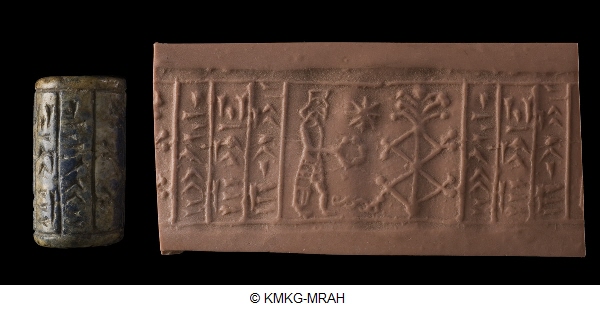
↑ , Cylinder seal with figure in front of a tree of life:
Cylinder seal with figure in front of a tree of life :
collectionName : IraninventoryNb : IR.0018
objectName :
objectTitle : Cylinder seal with figure in front of a tree of life
objectCulture : Achaemenid
geography :
dating : 559 BC - 330 BC
material :
technique :
dimensions : Height: 2,7 cm
legalRightOwner : Musées royaux d'art et d'histoire/Koninklijke Musea voor Kunst en Geschiedenis
objectDescription : This seal has been quite famous ever since the identification of its inscription as an Old Persian name by the assyriologists J. Ménant and J. Oppert. Given in 1861 by the art collector Gustave Hagemans to the then Musée des Armures in the Porte de Hal, Brussels (now preserved in the Musées royaux d’Art et d’Histoire), the cylinder seal was first published, with a picture and a transliteration, in Ménant 1877. At that time Old Persian inscriptions were scarce, hence its success. The seal shows a male figure, a wreath (?) in his hand, standing near a tree. The stylized tree is reminiscent of Neo-Assyrian iconography, and the offering of a crown is uncommon and attested rather from the Parthian period in the 3rd century BC. No parallel found. The framed inscription is composed of three lines, vertically written, from bottom to top, and to be read on the seal, which is unusual for the Achaemenid period. The bizarre spelling of Xerxes was first read as “Kharsā…siyā” (Kharsā son of Siyā or Kharsāisiyā; Ménant 1878a), “Khsarasasya” or alternatively “the woman Khsarsya” (Ménant 1886, 172), then as “Kharšadašia” (Speleers 1923, 217). The particle ma- was interpreted as a logogram for “seal” by Ménant, some sort of abbreviation of the Old Persian māraka (cf. also Oppert 1884; Kent 1953, 201) and by a 1st person pronoun by Speleers (“Je (suis) Kharšadašia”). Yet, the 1st person should be adam, as in other seals, and this ma- is considered as dubious (Kent 1953, 201). In the da-sign, the top horizontal wedge is missing. The stroke after the first sign (ma) is a divider, transliterated here as “:”. The form X-r-š-a-d?-š-y-a should probably be read X-š-y-a-r-š-a, after inverting line 2 and line 3 (Mayrhofer 1979) to have a nominative sing. ending in –ša. ma:x- r-š-a- da!-š-y-a “Seal of (?) Xerxes” This inscription is either a late (but genuine) imitation, or a modern forgery. The unusual lay-out of the inscription, the misshaped design and the bizarre spelling for the name of Xerxes, not to mention the iconography, could point to a forgery. However, in 1888 only three additional cylinder seals with Old Persian cuneiform signs were known to scholars (Ménant 1888, 12), all preserved in the collections of the British Museum, but we know that copies were produced in Iran at that time.

↑ , Cylinder seal with two gods:
Cylinder seal with two gods :
collectionName : IraninventoryNb : IR.0239
objectName :
objectTitle : Cylinder seal with two gods
objectCulture : Iranian
geography :
dating : 299 BC - AD 300
material :
technique :
dimensions : Height: 3,2 cm
legalRightOwner : Musées royaux d'art et d'histoire/Koninklijke Musea voor Kunst en Geschiedenis
objectDescription : A nude male with mace represents probably the Greek god Heracles, who was introduced in Iran by Alexander the Great and who was assimilated into the Iranian pantheon. Behind him is a winged Nikè. A nude man in front of him seems to hold three twigs, possibly a barsom. A fourth figure stands in front of an altar. There are Aramaic inscriptions. Old number: O.01446.
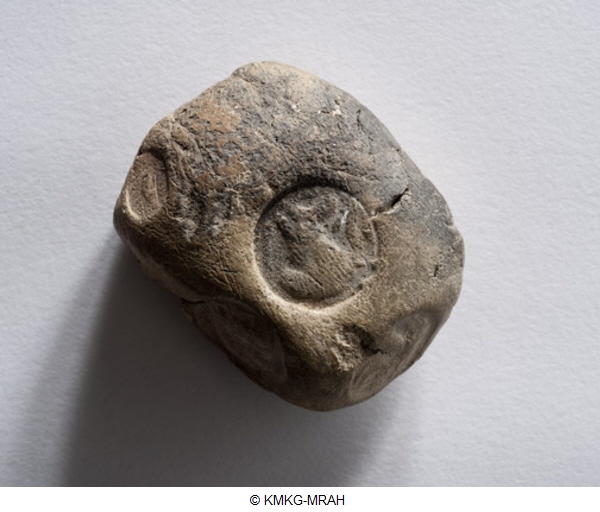
↑ , Bull with four stamps:
Bull with four stamps :
collectionName : IraninventoryNb : IR.1092
objectName :
objectTitle : Bull with four stamps
objectCulture : Sasanian
geography :
dating : AD 224 - AD 642
material :
technique :
dimensions :
legalRightOwner : Musées royaux d'art et d'histoire/Koninklijke Musea voor Kunst en Geschiedenis
objectDescription : Bull with four Sassanid seals. Traces of a wire. Impression A: a dog? Impression B: a sitting quadruped, probably winged. Impression C: a sitting quadruped. D: standing quadruped. A deer? Old number: O.03054.

↑ , Orgue de l’église paroissiale de Ninove.:
Orgue de l’église paroissiale de Ninove. :
collectionName : Iconography MIMinventoryNb : MIMICO.ACP.140
objectName :
objectTitle : Orgue de l’église paroissiale de Ninove.
objectCulture :
geography :
dating : ca. AD 1930
material :
technique :
dimensions :
legalRightOwner : Musées royaux d'art et d'histoire/Koninklijke Musea voor Kunst en Geschiedenis
objectDescription : item has no descption

↑ , Cuneiform tablet with cylinder-seal impression:
Cuneiform tablet with cylinder-seal impression :
collectionName : Near EastinventoryNb : O.00058
objectName :
objectTitle : Cuneiform tablet with cylinder-seal impression
objectCulture : Mesopotamia
geography :
dating : 2150 BC - 2000 BC
material :
technique :
dimensions : Height: 4,1 cm, Width: 3,5 cm, Depth: 1,3 cm
legalRightOwner : Musées royaux d'art et d'histoire/Koninklijke Musea voor Kunst en Geschiedenis
objectDescription : Letter order. The imprint shows a standing figure holding a mace and a naked cavalier on a donkey. Three-line framed inscription with the last line indented. ab-ba-kal-la dub.sar ˹dumu lú-dnin-/gír-su˺ “Abba-kala, scribe, son of Lu-Ningirsu”. Only the upper part of the depiction is visible. Same seal on O.69 and O.836 ; most probably the same individual on the seal of O.71 but the seal is different.
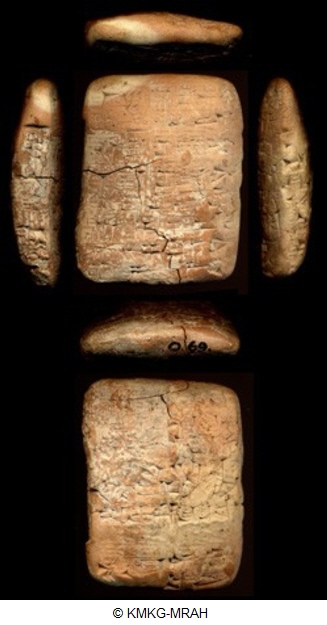
↑ , Cuneiform tablet with cylinder seal impression:
Cuneiform tablet with cylinder seal impression :
collectionName : Near EastinventoryNb : O.00069
objectName :
objectTitle : Cuneiform tablet with cylinder seal impression
objectCulture : Mesopotamia
geography :
dating : 2037 BC - 2029 BC
material :
technique :
dimensions : Height: 5,5 cm, Width: 4,4 cm, Depth: 1,9 cm
legalRightOwner : Musées royaux d'art et d'histoire/Koninklijke Musea voor Kunst en Geschiedenis
objectDescription : Account of livestock. Seal of Abkalla. A standing figure holding a mace and a rider on a donkey. 9nd year of Šu-Sîn. Three-line framed inscription with the last line indented. ab-ba-kal-la dub.sar dumu lú-dnin-/gír-su “Abba-kala, scribe, son of Lu-Ningirsu”. Same seal on O.58 and O.836 ; most probably the same individual on O.71 but the seal is different.

↑ , Cuneiform tablet with cylinder seal impression:
Cuneiform tablet with cylinder seal impression :
collectionName : Near EastinventoryNb : O.00071
objectName :
objectTitle : Cuneiform tablet with cylinder seal impression
objectCulture : Mesopotamia
geography :
dating : 2037 BC - 2029 BC
material :
technique :
dimensions : Height: 6 cm, Width: 4,5 cm, Depth: 1,7 cm
legalRightOwner : Musées royaux d'art et d'histoire/Koninklijke Musea voor Kunst en Geschiedenis
objectDescription : Account of livestock sacrificed in Lu-ha ma-si (?)-ki. Year eight of Gimil-Sin (Shu-Suen). Three-line framed inscription. ab-ba-kal-la dub.[sar] dumu lú-dnin-˹gír˺-[su] “Abba-kala, scribe, son of Lu-Ningirsu”. Most probably the same individual on the seal of O.58, O.69 and O.836 but the seal is different.

↑ , Cuneiform tablet with cylinder seal impression:
Cuneiform tablet with cylinder seal impression :
collectionName : Near EastinventoryNb : O.00108
objectName :
objectTitle : Cuneiform tablet with cylinder seal impression
objectCulture : Mesopotamia
geography :
dating : 2094 BC - 2004 BC
material :
technique :
dimensions : Height: 5 cm, Width: 4,7 cm, Depth: 1,9 cm
legalRightOwner : Musées royaux d'art et d'histoire/Koninklijke Musea voor Kunst en Geschiedenis
objectDescription : Payment of weavers in barley, in the new house, from the 54th year of Bur-sin, with the seal of the chef of the weavers. The imprint shows a figure with his hand lifted, at face-height. He holds a client, whom he is introducing, by the wrist. The imprint, however, does not show a deity seated on a cubic chair, as is the habit on presentation scenes. Another figure probably belongs to a different seal. He stands and wears a many-horned mitra. His right leg is on an elevated platform. One hand rests on an object, the other near his belt. Seal 1 (left) – rather faded. Four-line framed inscription and part of two standing figures (worshipper and king with mace?). Line 3: an alternative reading would be lugal-˹du10?˺-ga. lugal-˹ú˺-šim-˹e˺ dub.˹sar˺ dumu lú?-˹du10?˺-ga šabra l[ugal?] “Lugal-ušim, scribe, son of Lu-duga the chief administrator of the king”. Seal 2 (right) – very faded. Four-line framed inscription and part of a presentation scene. According to the text, it should belong to Ur-Baba the second scribe, but the traces are too faint to read the expected ur-(d)ba-ba6. ˹x-(x-)x-x˺ dub?-[sar] dumu [x x]-x [x x (x)] “… scribe (?), son of …, (profession)”.
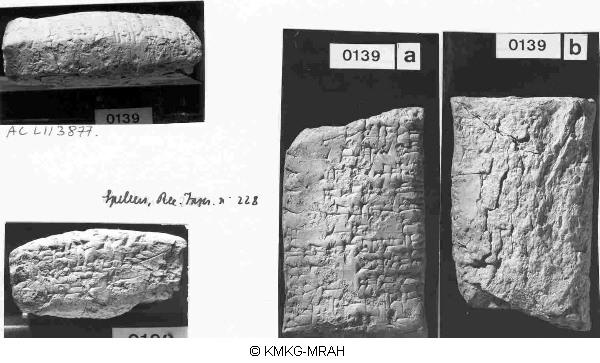
↑ , Cuneiform tablet with cylinder seal impression:
Cuneiform tablet with cylinder seal impression :
collectionName : Near EastinventoryNb : O.00139
objectName :
objectTitle : Cuneiform tablet with cylinder seal impression
objectCulture : Mesopotamia
geography :
dating : 1792 BC - 1750 BC
material :
technique :
dimensions : Height: 8,5 cm, Width: 5,5 cm
legalRightOwner : Musées royaux d'art et d'histoire/Koninklijke Musea voor Kunst en Geschiedenis
objectDescription : Record of a payment of barley to the palace near the dock of Adab. 36th year of Hammurabi. Faint traces of one or two inscribed seals on the edge. A single line from the first seal – probably the name of owner of the seal – is preserved. Traces of a second seal, impressed in the other direction, are the remains of a three-line inscription. Seal 1: [ ]-˹x˺-d[x (x)] Seal 2: […] ˹DUMU x˺-[x (x)] ARAD ˹d?˺[x (x)] “…, son of …, slave of …”.

↑ , Cuneiform tablet with cylinder seal impression:
Cuneiform tablet with cylinder seal impression :
collectionName : Near EastinventoryNb : O.00143
objectName :
objectTitle : Cuneiform tablet with cylinder seal impression
objectCulture : Mesopotamia
geography :
dating : 1749 BC - 1712 BC
material :
technique :
dimensions : Height: 6 cm, Width: 4 cm
legalRightOwner : Musées royaux d'art et d'histoire/Koninklijke Musea voor Kunst en Geschiedenis
objectDescription : Cuneiform tablet, loan of barley “until the harvest”, Old Babylonian period, Samsu-iluna 6, seal imprint The tablet is poorly preserved and deteriorated since Speleers’s copy. Faint traces of three lines of an inscribed seal are visible on the edges and on the reverse but are almost illegible. This was probably the seal of the buyer, read by Speleers as “Nin-kī-ilišu” (probably Damqi-ilišu). A NI-sign is visible on the second line, below ì or lí (line 1). ˹dam?-x-ì-lí?-x˺ ˹DUMU? x-(x)-dx˺-[(x)] [x-(x)]-˹x˺ “…-ili…, [son of?] …”.
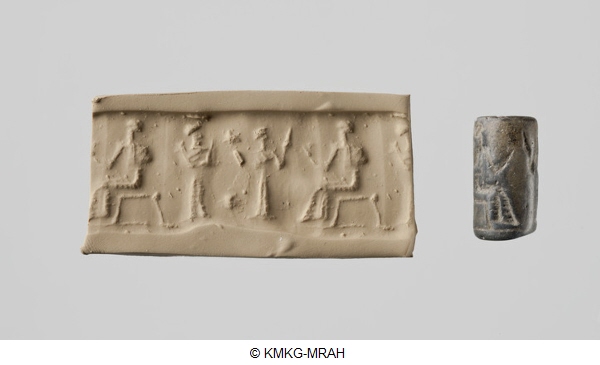
↑ , Cylinder seal with sitting deity:
Cylinder seal with sitting deity :
collectionName : Near EastinventoryNb : O.00441
objectName :
objectTitle : Cylinder seal with sitting deity
objectCulture : Akkadian
geography :
dating : 2350 BC - 2154 BC
material :
technique :
dimensions : Height: 2,1 cm
legalRightOwner : Musées royaux d'art et d'histoire/Koninklijke Musea voor Kunst en Geschiedenis
objectDescription : A deity sits on a cubic chair and raises a hand to two approaching figures. Some attributes were probably visible in the background.

↑ , Cunieform tablet with cylinder seal impression:
Cunieform tablet with cylinder seal impression :
collectionName : Near EastinventoryNb : O.00836
objectName :
objectTitle : Cunieform tablet with cylinder seal impression
objectCulture : Mesopotamia
geography :
dating : 2112 BC - 2004 BC
material :
technique :
dimensions : Height: 4,1 cm, Width: 3,5 cm
legalRightOwner : Musées royaux d'art et d'histoire/Koninklijke Musea voor Kunst en Geschiedenis
objectDescription : Account of oxen and sheep, year of the temple of Sahar. Three-line framed inscription with the last line indented, with part of the iconography (a rider on a donkey). Same seal on O.58 and O.69; most probably the same individual on the seal of O.71 but the seal is different. ab-ba-kal-la dub.sar dumu lú-dnin-/gír-su “Abba-kala, scribe, son of Lu-Ningirsu”.

↑ , Cylinder seal with battle scene:
Cylinder seal with battle scene :
collectionName : Near EastinventoryNb : O.01576
objectName :
objectTitle : Cylinder seal with battle scene
objectCulture : Akkadian
geography :
dating : 2350 BC - 2154 BC
material :
technique :
dimensions : Height: 3 cm, Width: 1,5 cm
legalRightOwner : Musées royaux d'art et d'histoire/Koninklijke Musea voor Kunst en Geschiedenis
objectDescription : Battle with four animals, probably lions. A vertical line, with two smaller, horizontal lines, is visible behind them.

↑ , Cylinder seal with god:
Cylinder seal with god :
collectionName : Near EastinventoryNb : O.02784
objectName :
objectTitle : Cylinder seal with god
objectCulture : Phoenician
geography :
dating : 500 BC - 301 BC
material :
technique :
dimensions : Height: 2,8 cm
legalRightOwner : Musées royaux d'art et d'histoire/Koninklijke Musea voor Kunst en Geschiedenis
objectDescription : Bust of a god in solar disk with four wings (Ahura Mazda?), followed by the title and name of ship captain (or fleet commander?) Padiaset, in hieroglyphs. Probably a transcription of a Phoenician name with theonym Asiti, a goddess worshipped in Sidon.

↑ , Cylinder seal with human figure, fire and two gods:
Cylinder seal with human figure, fire and two gods :
collectionName : Near EastinventoryNb : O.03530
objectName :
objectTitle : Cylinder seal with human figure, fire and two gods
objectCulture : Assyrian
geography :
dating : 605 BC - 539 BC
material :
technique :
dimensions : Height: 3,2 cm
legalRightOwner : Musées royaux d'art et d'histoire/Koninklijke Musea voor Kunst en Geschiedenis
objectDescription : A bearded, human figure stands before a fire between two deities. To the right stands a god on a bull (probably Adad), to the left a goddess in a man’s clothes, on a lioness (Ishtar).

↑ , Glass plate of a magical lantern: four scenes (probably taken from fairy tales):
Glass plate of a magical lantern: four scenes (probably taken from fairy tales) :
collectionName : Historical photographsinventoryNb : PH 0004070
objectName :
objectTitle : Glass plate of a magical lantern: four scenes (probably taken from fairy tales)
objectCulture :
geography :
dating : unknown
material :
technique :
dimensions : Height: 10 cm, Width: 30 cm
legalRightOwner : Musées royaux d'art et d'histoire/Koninklijke Musea voor Kunst en Geschiedenis
objectDescription : item has no descption
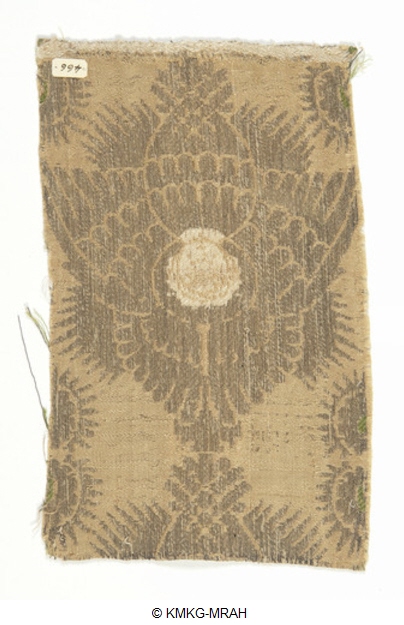
↑ , Fragment of silk:
Fragment of silk :
collectionName : TextileinventoryNb : Tx.0466
objectName :
objectTitle : Fragment of silk
objectCulture :
geography :
dating : AD 1301 - AD 1400 (uncertain)
material :
technique :
dimensions : Height: 21,5 cm, Width: 13,5 cm
legalRightOwner : Musées royaux d'art et d'histoire/Koninklijke Musea voor Kunst en Geschiedenis
objectDescription : item has no descption

↑ , :
:
collectionName : TextileinventoryNb : Tx.0467
objectName :
objectTitle :
objectCulture :
geography :
dating : AD 1301 - AD 1500
material :
technique :
dimensions : Height: 24,5 cm, Width: 28,5 cm
legalRightOwner : Musées royaux d'art et d'histoire/Koninklijke Musea voor Kunst en Geschiedenis
objectDescription : item has no descption

↑ , Band of silk:
Band of silk :
collectionName : TextileinventoryNb : Tx.0468
objectName :
objectTitle : Band of silk
objectCulture :
geography :
dating : AD 1301 - AD 1500
material :
technique :
dimensions : Height: 46 cm, Width: 9 cm
legalRightOwner : Musées royaux d'art et d'histoire/Koninklijke Musea voor Kunst en Geschiedenis
objectDescription : item has no descption

↑ , :
:
collectionName : TextileinventoryNb : Tx.0469
objectName :
objectTitle :
objectCulture :
geography :
dating : AD 1301 - AD 1500
material :
technique :
dimensions : Height: 21 cm, Width: 46,5 cm
legalRightOwner : Musées royaux d'art et d'histoire/Koninklijke Musea voor Kunst en Geschiedenis
objectDescription : item has no descption

